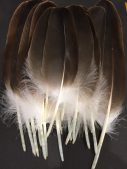Potawatomi use and wear plumage with honor and reverence. Tribal oral tradition says “the eagle delivers a message to the Creator that people on this earth are still doing the right thing, so the sun comes up and the Earth lives another day,” according to Citizen Potawatomi Nation Tribal Chairman John “Rocky” Barrett in his “Caring for Eagle Feathers” brochure available at cpn.news/feathers.
While using feathers during ceremonies and smudging, Potawatomi respect the connection between man and eagles as messengers and prayer carriers.
“When we use feathers to smudge, the smoke is that physical manifestation of our prayers rising to the heavens and that is why we use an eagle feather,” said CPN Aviary Manager Jennifer Randell. “The eagle feather has two sides: They represent the balance of all that is male and female, night and day, right and wrong, as well as life and death.”
The CPN seal also depicts those two sides: Feathers adorn both a calumet, or peace pipe, and a war club.
Different plumes carry various meanings, and Tribal members use them accordingly. The red-tailed hawk represents veterans and warriors because of its territorial and protective nature, said Randell. Potawatomi commonly create regalia items such as bustles, roaches and fans with feathers while considering those associations.
Family Reunion Festival is this month, and the Honored Family dances, Grand Entry and competitions require proper regalia.

Making a fan
Most often fans are made from the tail or wing feathers of an eagle or hawk along with wood glue and a premade, wooden fan handle (available at the Citizen Potawatomi Gift Shop).
When making a loose wing fan, lay the feathers out and make the desired shape before attaching them. Use one with a pointed end as the “anchor,” placing the others behind it. Next, trim the feathers’ bottoms (the shaft) to be flush with the handle, assuring a secure fit.
Using the glue, begin with the spiked feather and cover both its bottom and the gap in the handle where it will rest. Let it dry, which can take up to half an hour. Repeat this process with the rest of the feathers, placing them one-by-one in the chosen order.
Double-check that each placement is tight and the top of them are even. While being waved, the feathers should move together. Next, decorate the handle and feather bases with your choice of beadwork, paint, quillwork, leather and yarn.
Potawatomi consider it an honor to enter the arena with these kinds of regalia pieces because “dancing is prayer in motion,” Randell said.
An individual’s age and responsibility level should be taken into account when considering plumage ownership. Potawatomi liken a feather touching the ground during a powwow to a warrior falling in battle. Fallen feathers are prayed over and smudged.
“Once the dance has been stopped when a feather is dropped, it is up to the veterans who retrieve that feather whether or not they return it to the dancer,” Randell said. “I have seen elders keep fallen feathers if they decide that the dancer was not ready or responsible enough to have their feather back.”
Proper maintenance
“Once feathers are damaged by bugs or water, they are often not repairable. To not protect them is disrespectful,” Randell said. “To have a feather or feathers is an honor, and it is believed that to wear or hold an eagle feather causes the Creator to take immediate notice.”
They should be kept away from food, alcohol, animals and negative energy. Clean, dry environments are ideal. Cedar is a natural bug repellant, and keeping fans and ceremonial feathers in cedar boxes is sufficient. Feathers are meant to be used in prayer, smudged regularly with sage and exposed to light.
When someone is gifted a feather, “they should be told the story of the eagle delivering the message to the Creator,” Barrett said. “That there are still faithful on the Earth (prayer smoke rising). That (the earth) should not be destroyed by cold from the sun not rising.”
Eagles naturally molt between about May and September. Tribal members can request placement on the CPN aviary’s feather waiting list. They can also apply to the U.S. Fish and Wildlife Services’ National Eagle Repository. Filling requests often takes months. Visit
cpn.news/aviary for more information.
